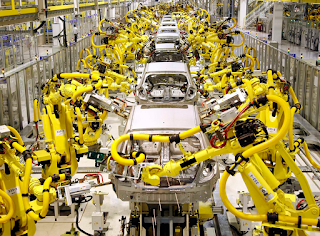Week 3- Art + Robotics
 This weeks material was interesting as it not only focused
on how robotics and art influence each other in the present day, but the
lectures informed us on how the technological changes from the industrial
revolution have also influenced this. Technology and mass production is what
has helped the invention of jobs, making differing objects and making ideas
available to larger audiences leading to new discoveries in today’s world. In
Lecture Part 1, Professor discusses the printing press and how its invention
created the ability for information to be transmitted rapidly. This allowed for mass production of
information from brilliant minds to transmit their knowledge around the world
and thus A robotic assembly line
This weeks material was interesting as it not only focused
on how robotics and art influence each other in the present day, but the
lectures informed us on how the technological changes from the industrial
revolution have also influenced this. Technology and mass production is what
has helped the invention of jobs, making differing objects and making ideas
available to larger audiences leading to new discoveries in today’s world. In
Lecture Part 1, Professor discusses the printing press and how its invention
created the ability for information to be transmitted rapidly. This allowed for mass production of
information from brilliant minds to transmit their knowledge around the world
and thus A robotic assembly line
changed the way we today transmit our knowledge. What I find most
interesting about in industrial revolution and the way it changed our world is
the assembly line. Professor discussed
this in short but how I see it is the technological advances like robots has
changed job availability and the way things are made.
Henry Ford created the assembly line, through his mass
production of automobiles. However we can see today, robots and other machinery
now create society automobiles.
It is almost ironic to me that the creation of the printing
press in the early industrial revolution created many job opportunities. And
today those robots are the major factors of the assembly line. However we can also see that this has created
jobs in itself, in a breakdown of US jobs in manufacturing we can see that the
use of technology and robots are making our jobs safer, more
efficient and
actually creating jobs.
Henry Fords Automobile assembly line
In regards to the art and robot relationship, it is
interesting to note the more modern forms of art that have taken a back seat to
technological advanced art like videography and pictures. This has allowed for
more human interaction, and simply makes the artwork easier and more convenient.
Walter Benjamin made this observation in his book “the work of art in the age
of mechanical production”, predicting that mechanics are going to strip
societies of uniqueness and authenticity. This is very true and can be put down
to societies need for efficiency and mass production.
Sources
Ajayan, Unni. “How has technology changed art”. Josic Investment Details - Department of
Human Services
Burrows, Brianna. “What is the difference between a bachelor
of Arts and a Bachelor of Sciences?” Study
USA, https://studyusa.com/en/a/1241/what-is-the-difference-between-a-bachelor-of-arts-and-a-bachelor-of-sciences.
Corday, Robert. “the evolution of assembly lines: A brief
history”. Robohub http://robohub.org/the-evolution-of-assembly-lines-a-brief-history/
McCutcheon, Robert. “The new hire: How a new generation of
robots in transforming manufacturing” PWC.
https://www.pwc.com/us/en/industries/industrial-products/library/robotic-trends-changing-manufacturing.html
Rendall, Mathew. “Industrial robots will replace
manufacturing jobs- and it’s a good thing” Tech
Crunch, https://techcrunch.com/2016/10/09/industrial-robots-will-replace-manufacturing-jobs-and-thats-a-good-thing/
Rieland, Randy. “7 ways technology is changing how art is
made” https://www.smithsonianmag.com/arts-culture/7-ways-technology-is-changing-how-art-is-made-180952472/
Pictures
Assembly Line. Industrial
Business Technology News http://www.xiduanpress.com/industrial-machines/assembly-line/
Ford assembly line, 1913
Why does it have to be man vs machine in BPM ? https://bpmredux.wordpress.com/2012/03/27/why-does-it-have-to-be-man-vs-machine-in-bpm/



Bronte, I really enjoyed reading your blog this week. I think that the way you relay the information is smooth. As for the material, it is quite interesting. I like that you did a good job of laying out the pluses and minuses of robotic advancement. Yes, robots could serve us great purpose in society, but I think that there is a large danger if used improperly. In politics today, people are constantly saying that the U.S. needs more jobs. In Oregon, they have people working to pump gas at gas stations for the sole purpose to create a job. What happens when robots can do everything humans can and they are able to work in factories, diagnose problems with cars and fix them, make our food, etc.? Your blog definitely does a great job of touching on these! :)
ReplyDelete